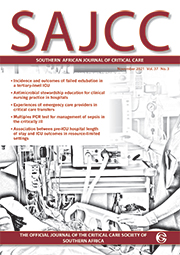Articles

Low albumin levels are associated with mortality in the critically ill: A retrospective observational study in a multidisciplinary intensive care unit
Abstract
Background. Albumin is a determinant of plasma colloid oncotic pressure and buffering capacity. It is a carrier protein for drugs and is important for normal functioning of the glycocalyx. Hypoalbuminaemia is common in the critically ill and has been associated with adverse outcomes. The association between hypoalbuminaemia and outcome has not been specifically explored in the South African context.
Objectives. To determine whether albumin levels on admission and changes in albumin levels were associated with intensive care unit (ICU) mortality in a heterogenous critically ill population.
Methods. This was a retrospective observational study of 247 adult patients who were admitted to a multidisciplinary ICU. Albumin levels were measured on admission and 48 hours later, alongside other biochemical and clinical parameters to determine whether they were predictive of ICU mortality.
Results. The lowest level of albumin on admission was 8 g/L and the highest was 43 g/L. The incidence of hypoalbuminaemia (using the laboratory reference range) was 93.9% on admission and 99.4% at 48 hours. Receiver operating characteristic curve analysis provided an optimal albumin cut-off of 18.5 g/L. Using this cut-off, hypoalbuminaemia at admission and at 48 hours was associated with increased ICU mortality. Hypoalbuminaemia at admission was an independent predictor of mortality using multivariable analysis (OR 3.74; 95% confidence interval 1.87 - 4.48).
Conclusion. Hypoalbuminaemia is associated with increased ICU mortality. There is currently no evidence to support the use of albumin replacement therapy. Further research is required to determine its role in critically ill patients.
Authors' affiliations
A Atrash, Discipline of Anaesthesiology and Critical Care, School of Clinical Medicine, University of KwaZulu-Natal, Durban, South Africa
K de Vasconcellos, Discipline of Anaesthesiology and Critical Care, School of Clinical Medicine, University of KwaZulu-Natal, Durban, South Africa
Full Text
Cite this article
Article History
Date published: 2020-12-01
Article Views
Full text views: 805




1.jpg)
Comments on this article
*Read our policy for posting comments here